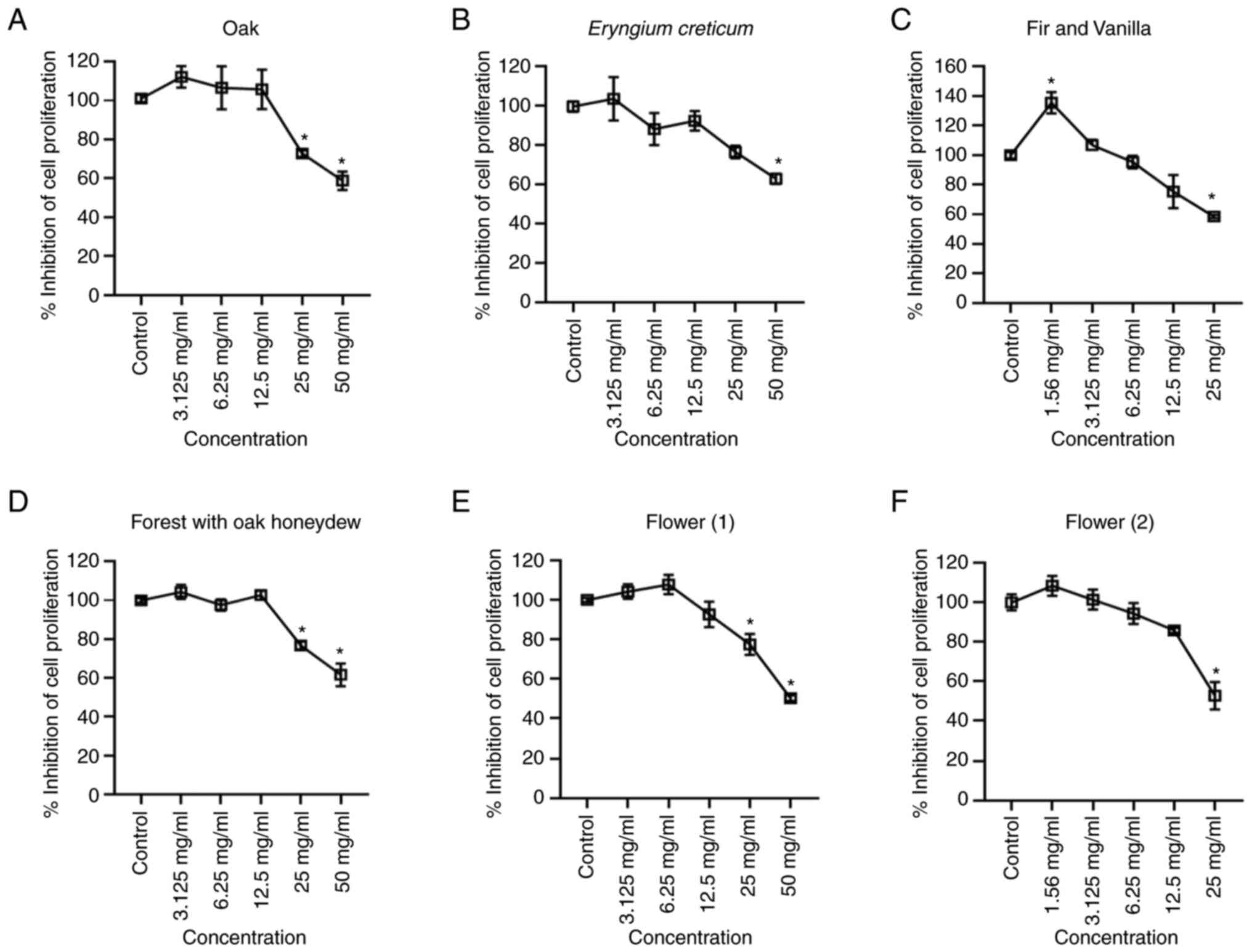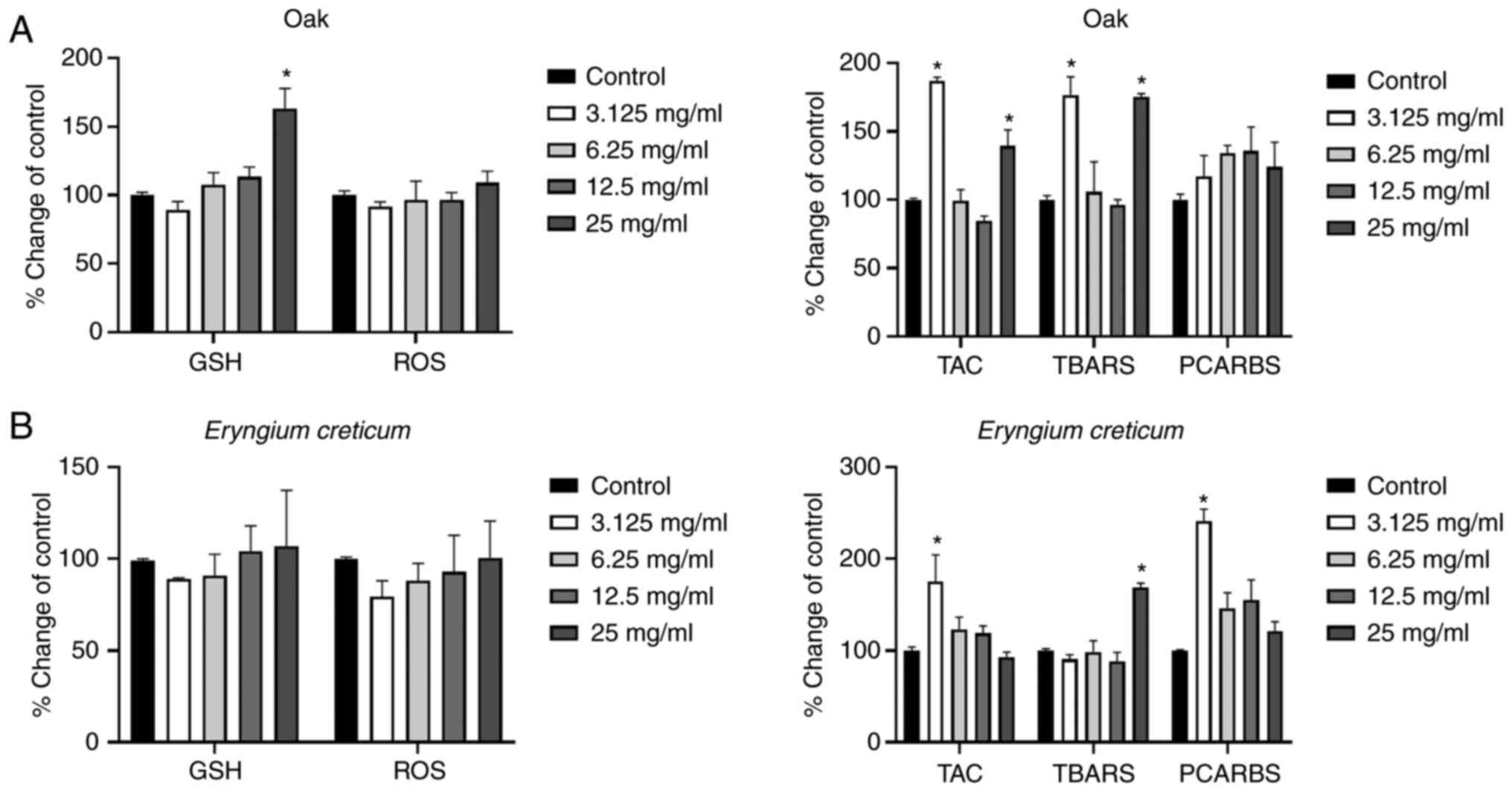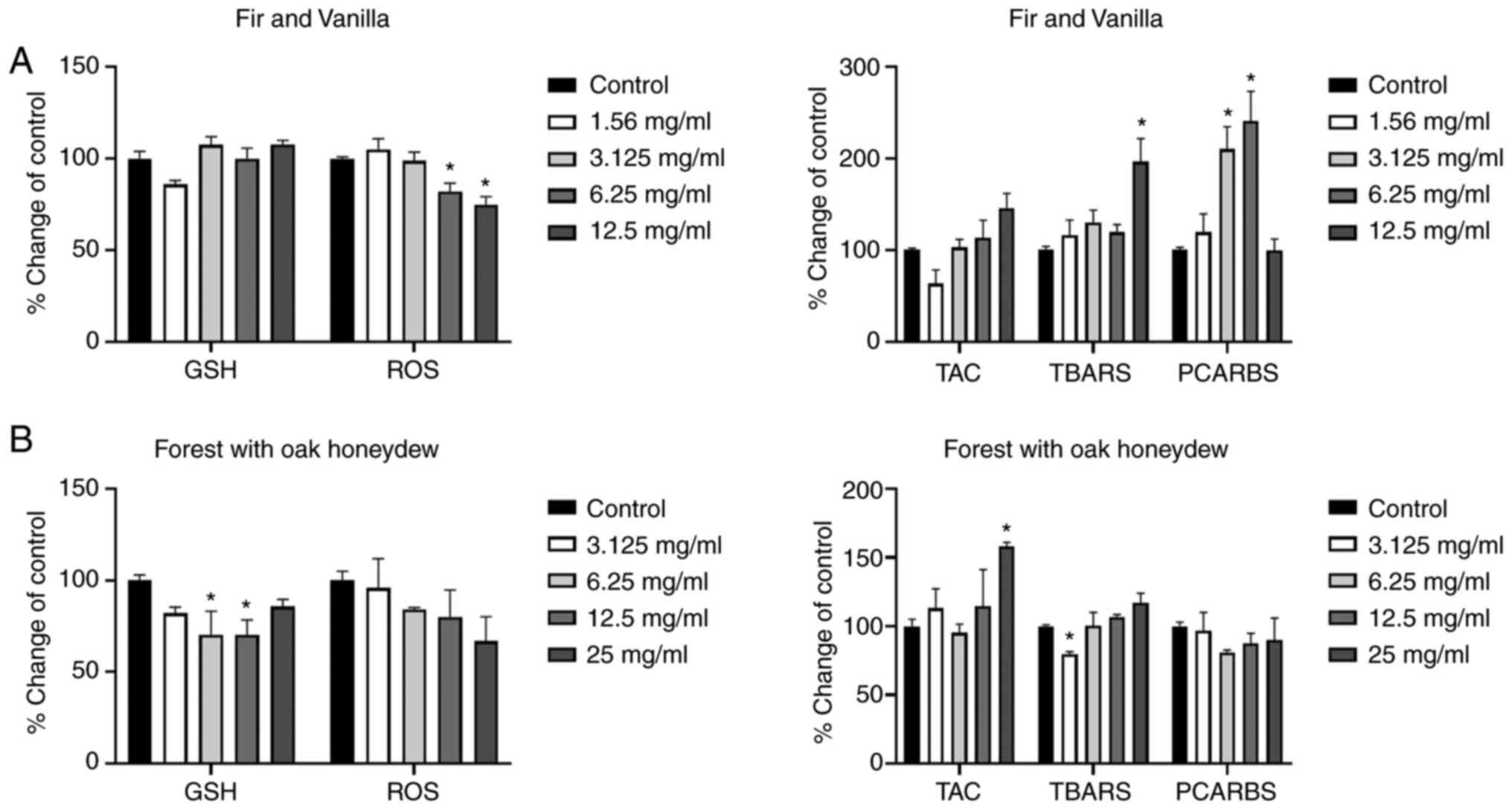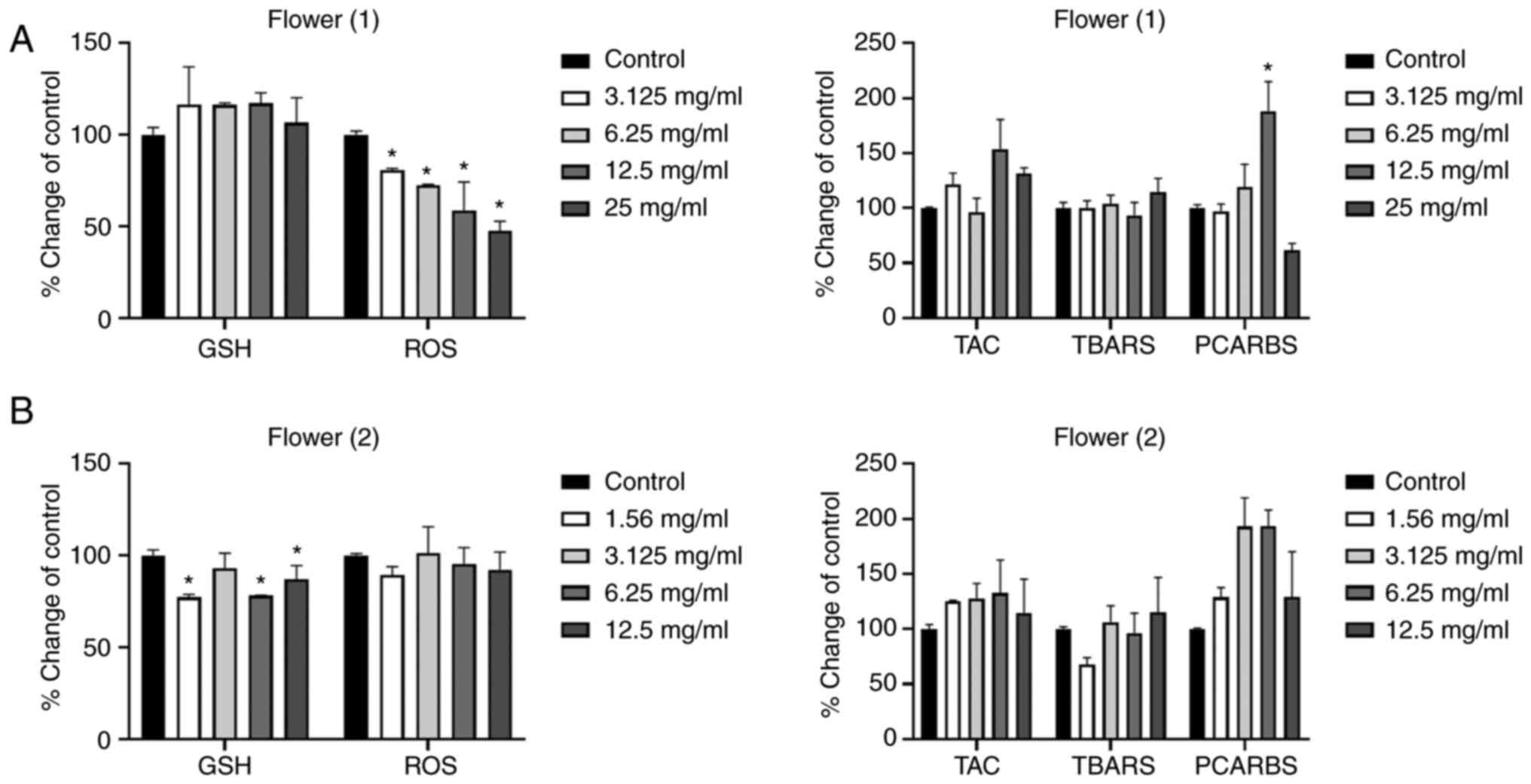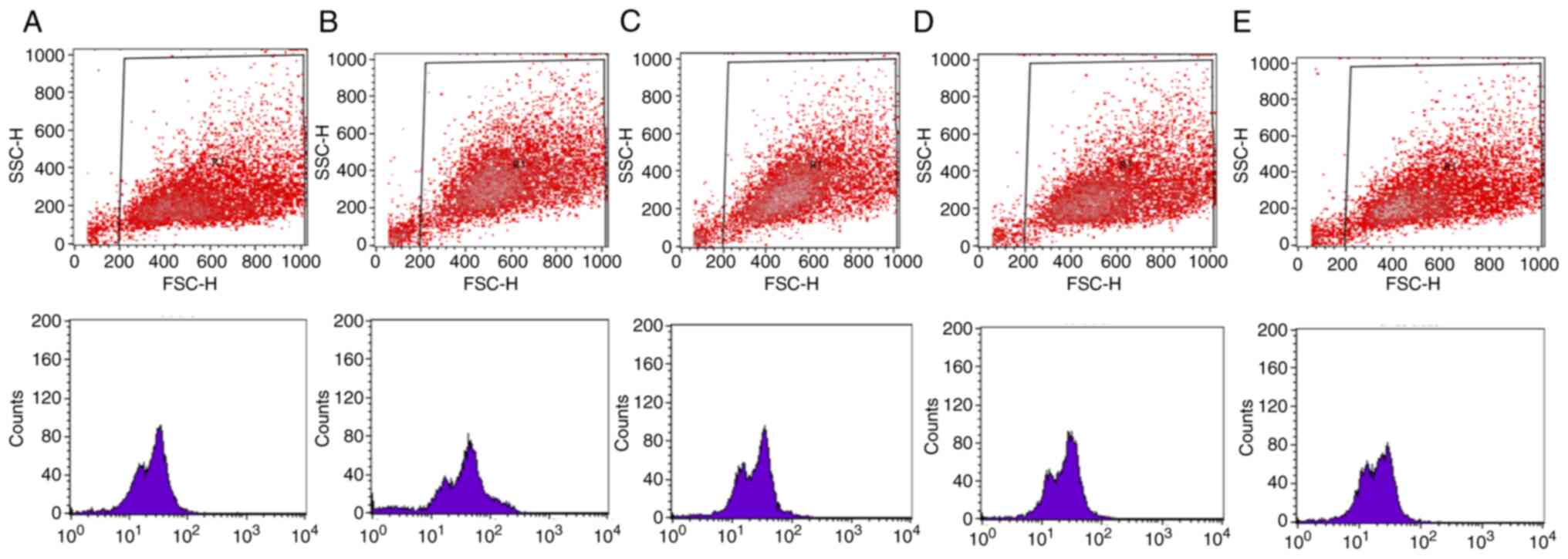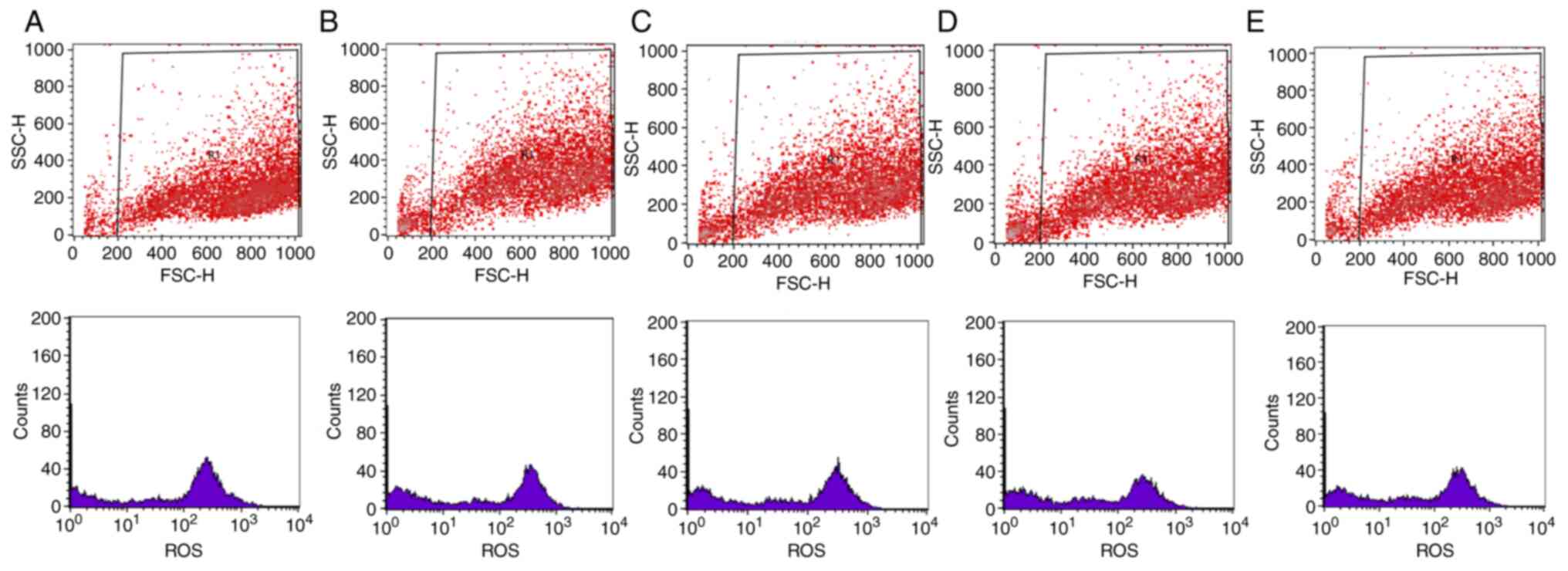|
1
|
Tahir HE, Xiaobo Z, Zhihua L, Jiyong S,
Zhai X, Wang S and Mariod AA: Rapid prediction of phenolic
compounds and antioxidant activity of Sudanese honey using Raman
and Fourier transform infrared (FT-IR) spectroscopy. Food Chem.
226:202–211. 2017. View Article : Google Scholar : PubMed/NCBI
|
|
2
|
Di Marco G, Manfredini A, Leonardi D,
Canuti L, Impei S, Gismondi A and Canini A: Geographical, botanical
and chemical profile of monofloral Italian honeys as food quality
guarantee and territory brand. Plant Biosyst. 151:450–463. 2017.
View Article : Google Scholar
|
|
3
|
Martinello M and Mutinelli F: Antioxidant
activity in bee products: A review. Antioxidants (Basel).
10:712021. View Article : Google Scholar : PubMed/NCBI
|
|
4
|
Alvarez-Suarez JM, Gasparrini M,
Forbes-Hernández TY, Mazzoni L and Giampieri F: The composition and
biological activity of honey: A focus on manuka honey. Foods.
3:420–432. 2014. View Article : Google Scholar : PubMed/NCBI
|
|
5
|
Samarghandian S, Farkhondeh T and Samini
F: Honey and health: A review of recent clinical research.
Pharmacognosy Res. 9:121–127. 2017.PubMed/NCBI
|
|
6
|
Bogdanov S, Jurendic T, Sieber R and
Gallmann P: Honey for nutrition and health: A review. J Am Coll
Nutr. 27:677–689. 2008. View Article : Google Scholar : PubMed/NCBI
|
|
7
|
Alvarez-Suarez J, Giampieri F and Battino
M: Honey as a source of dietary antioxidants: Structures,
bioavailability and evidence of protective effects against human
chronic diseases. Curr Med Chem. 20:621–638. 2013. View Article : Google Scholar : PubMed/NCBI
|
|
8
|
Gheldof N, Wang XH and Engeseth NJ:
Buckwheat honey increases serum antioxidant capacity in humans. J
Agric Food Chem. 51:1500–1505. 2003. View Article : Google Scholar : PubMed/NCBI
|
|
9
|
Meo SA, Al-Asiri SA, Mahesar AL and Ansari
MJ: Role of honey in modern medicine. Saudi J Biol Sci. 24:975–978.
2017. View Article : Google Scholar : PubMed/NCBI
|
|
10
|
Al-Waili NS and Boni NS: Natural honey
lowers plasma prostaglandin concentrations in normal individuals. J
Med Food. 6:129–133. 2003. View Article : Google Scholar : PubMed/NCBI
|
|
11
|
Patton T, Barrett J, Brennan J and Moran
N: Use of a spectrophotometric bioassay for determination of
microbial sensitivity to manuka honey. J Microbiol Methods.
64:84–95. 2006. View Article : Google Scholar : PubMed/NCBI
|
|
12
|
Erejuwa OO: Effect of honey in diabetes
mellitus: Matters arising. J Diabetes Metab Disord. 13:232014.
View Article : Google Scholar : PubMed/NCBI
|
|
13
|
Jiang L, Xie M, Chen G, Qiao J, Zhang H
and Zeng X: Phenolics and carbohydrates in buckwheat honey regulate
the human intestinal microbiota. Evid Based Complement Alternat
Med. 2020:64329422020. View Article : Google Scholar : PubMed/NCBI
|
|
14
|
Azman KF, Zakaria R, Othman Z and Abdul
Aziz CB: Neuroprotective effects of Tualang honey against oxidative
stress and memory decline in young and aged rats exposed to noise
stress. J Taibah Univ Sci. 12:273–284. 2018. View Article : Google Scholar
|
|
15
|
Erejuwa OO, Sulaiman SA and Ab Wahab MS:
Effects of honey and its mechanisms of action on the development
and progression of cancer. Molecules. 19:2497–2522. 2014.
View Article : Google Scholar : PubMed/NCBI
|
|
16
|
Candiracci M, Piatti E, Dominguez-Barragán
M, García-Antrás D, Morgado B, Ruano D, Gutiérrez JF, Parrado J and
Castaño A: Anti-inflammatory activity of a honey flavonoid extract
on lipopolysaccharide-activated N13 microglial cells. J Agric Food
Chem. 60:12304–12311. 2012. View Article : Google Scholar : PubMed/NCBI
|
|
17
|
Chan CW, Deadman BJ, Manley-Harris M,
Wilkins AL, Alber DG and Harry E: Analysis of the flavonoid
component of bioactive New Zealand mānuka (Leptospermum scoparium)
honey and the isolation, characterisation and synthesis of an
unusual pyrrole. Food Chem. 141:1772–1781. 2013. View Article : Google Scholar : PubMed/NCBI
|
|
18
|
Sergiel I, Pohl P and Biesaga M:
Characterisation of honeys according to their content of phenolic
compounds using high performance liquid chromatography/tandem mass
spectrometry. Food Chem. 145:404–408. 2014. View Article : Google Scholar : PubMed/NCBI
|
|
19
|
Jaganathan SK and Mandal M:
Antiproliferative effects of honey and of its polyphenols: A
review. J Biomed Biotechnol. 2009:8306162009. View Article : Google Scholar : PubMed/NCBI
|
|
20
|
Alshammari GM, Ahmed MA, Alsulami T,
Hakeem MJ, Ibraheem MA and Al-Nouri DM: Phenolic compounds,
antioxidant activity, ascorbic acid, and sugars in honey from
ingenious hail province of Saudi Arabia. Appl Sci. 12:83342022.
View Article : Google Scholar
|
|
21
|
Thakur M, Singh K and Khedkar R:
11-Phytochemicals: Extraction process, safety assessment,
toxicological evaluations, and regulatory issues. Funct Preserv
Prop Phytochem. 341–361. 2020.
|
|
22
|
Arathi HS and Bernklau E:
Context-dependent effect of dietary phytochemicals on honey bees
exposed to a pesticide, thiamethoxam. J Insect Sci. 21:112021.
View Article : Google Scholar
|
|
23
|
Liu JR, Ye YL, Lin TY, Wang YW and Peng
CC: Effect of floral sources on the antioxidant, antimicrobial, and
anti-inflammatory activities of honeys in Taiwan. Food Chem.
139:938–943. 2013. View Article : Google Scholar : PubMed/NCBI
|
|
24
|
Pita-Calvo C and Vázquez M: Differences
between honeydew and blossom honeys: A review. Trends Food Sci
Technol. 59:79–87. 2017. View Article : Google Scholar
|
|
25
|
Villalpando-Aguilar JL, Quej-Chi VH,
López-Rosas I, Cetzal-Ix W, Aquino-Luna VÁ, Alatorre-Cobos F and
Martínez-Puc JF: Pollen types reveal floral diversity in natural
honeys from campeche, Mexico. Diversity. 14:7402022. View Article : Google Scholar
|
|
26
|
Gül A and Pehlivan T: Antioxidant
activities of some monofloral honey types produced across Turkey.
Saudi J Biol Sci. 25:1056–1065. 2018. View Article : Google Scholar : PubMed/NCBI
|
|
27
|
Porcza LM, Simms C and Chopra M: Honey and
cancer: Current status and future directions. Diseases. 4:302016.
View Article : Google Scholar : PubMed/NCBI
|
|
28
|
Hossain KS, Hossain MG, Moni A, Rahman MM,
Rahman UH, Alam M, Kundu S, Rahman MM, Hannan MA and Uddin MJ:
Prospects of honey in fighting against COVID-19: Pharmacological
insights and therapeutic promises. Heliyon. 6:e057982020.
View Article : Google Scholar : PubMed/NCBI
|
|
29
|
Aliyu M, Odunola OA, Farooq AD, Rasheed H,
Mesaik AM, Choudhary MI, Channa IS, Khan SA and Erukainure OL:
Molecular mechanism of antiproliferation potential of Acacia honey
on NCI-H460 cell line. Nutr Cancer. 65:296–304. 2013. View Article : Google Scholar : PubMed/NCBI
|
|
30
|
Pichichero E, Cicconi R, Mattei M, Muzi MG
and Canini A: Acacia honey and chrysin reduce proliferation of
melanoma cells through alterations in cell cycle progression. Int J
Oncol. 37:973–981. 2010.PubMed/NCBI
|
|
31
|
Samarghandian S, Azimi Nezhad M and
Mohammadi G: Role of caspases, Bax and Bcl-2 in chrysin-induced
apoptosis in the A549 human lung adenocarcinoma epithelial cells.
Anticancer Agents Med Chem. 14:901–909. 2014. View Article : Google Scholar : PubMed/NCBI
|
|
32
|
Hassan MI, Mabrouk GM, Shehata HH and
Aboelhussein MM: Antineoplastic effects of bee honey and Nigella
sativa on hepatocellular carcinoma cells. Integr Cancer Ther.
11:354–363. 2012. View Article : Google Scholar : PubMed/NCBI
|
|
33
|
Pasupuleti VR, Sammugam L, Ramesh N and
Gan SH: Honey, propolis, and royal jelly: A comprehensive review of
their biological actions and health benefits. Oxid Med Cell Longev.
2017:12595102017. View Article : Google Scholar : PubMed/NCBI
|
|
34
|
Abdel Aziz Baiomy A, Rady HM, Amer MA and
Kiwan HS: Effect of some honey bee extracts on the proliferation,
proteolytic and gelatinolytic activities of the hepatocellular
carcinoma Hepg2 cell line. Aust J Basic Appl Sci. 3:2754–2769.
2009.
|
|
35
|
Singleton VL, Orthofer R and
Lamuela-Raventós RM: [14] Analysis of total phenols and other
oxidation substrates and antioxidants by means of folin-ciocalteu
reagent. Methods Enzymol. 299:152–178. 1999. View Article : Google Scholar
|
|
36
|
Brand-Williams W, Cuvelier ME and Berset
C: Use of a free radical method to evaluate antioxidant activity.
LWT-Food Sci Technol. 28:25–30. 1995. View Article : Google Scholar
|
|
37
|
Kouka P, Tekos F, Valta K, Mavros P,
Veskoukis AS, Angelis A, Skaltsounis AL and Kouretas D: Οlive tree
blossom polyphenolic extracts exert antioxidant and antimutagenic
activities in vitro and in various cell lines. Oncol Rep.
42:2814–2825. 2019.PubMed/NCBI
|
|
38
|
Kyriazis ID, Skaperda Z, Tekos F, Makri S,
Vardakas P, Vassi E, Patouna A, Terizi K, Angelakis C and Kouretas
D: Methodology for the biofunctional assessment of honey (review).
Int J Funct Nutr. 2:1–11. 2021. View Article : Google Scholar : PubMed/NCBI
|
|
39
|
Chung SK, Osawa T and Kawakishi S:
Hydroxyl radical-scavenging effects of spices and scavengers from
brown mustard (Brassica nigra). Biosci Biotechnol Biochem.
61:118–123. 1997. View Article : Google Scholar : PubMed/NCBI
|
|
40
|
Veskoukis A, Kerasioti E, Priftis A, Kouka
P, Spanidis Y, Makri S and Kouretas D: A battery of translational
biomarkers for the assessment of the in vitro and in vivo
antioxidant action of plant polyphenolic compounds: The biomarker
issue. Curr Opin Toxicol. 13:99–109. 2019. View Article : Google Scholar
|
|
41
|
Gülçin I, Küfrevioglu OI, Oktay M and
Büyükokuroglu ME: Antioxidant, antimicrobial, antiulcer and
analgesic activities of nettle (Urtica dioica L.). J
Ethnopharmacol. 90:205–215. 2004. View Article : Google Scholar : PubMed/NCBI
|
|
42
|
Priftis A, Mitsiou D, Halabalaki M, Ntasi
G, Stagos D, Skaltsounis LA and Kouretas D: Roasting has a distinct
effect on the antimutagenic activity of coffee varieties. Mutat Res
Toxicol Environ Mutagen. 829–830. 33–42. 2018.PubMed/NCBI
|
|
43
|
Tekos F, Makri S, Skaperda ZV, Patouna A,
Terizi K, Kyriazis ID, Kotseridis Y, Mikropoulou EV, Papaefstathiou
G, Halabalaki M and Demetrios K: Assessment of antioxidant and
antimutagenic properties of red and white wine extracts in vitro.
Metabolites. 11:4362021. View Article : Google Scholar : PubMed/NCBI
|
|
44
|
Yen GC and Duh PD: Antioxidative
properties of methanolic extracts from peanut hulls. J Am Oil Chem
Soc. 70:383–386. 1993. View Article : Google Scholar
|
|
45
|
Kerasioti E, Stagos D, Priftis A,
Aivazidis S, Tsatsakis AM, Hayes AW and Kouretas D: Antioxidant
effects of whey protein on muscle C2C12 cells. Food Chem.
155:271–278. 2014. View Article : Google Scholar : PubMed/NCBI
|
|
46
|
Jurič A, Huđek Turković A, Brčić Karačonji
I, Prđun S, Bubalo D and Durgo K: Cytotoxic activity of strawberry
tree (Arbutus unedo L.) honey, its extract, and homogentisic acid
on CAL 27, HepG2, and Caco-2 cell lines. Arh Hig Rada Toksikol.
73:158–168. 2022.PubMed/NCBI
|
|
47
|
Sun J, Zhang L, Zhang X, Hu Y, Ge C and
Fang J: An ultrafast turn-on thiol probe for protein labeling and
bioimaging. Analyst. 141:2009–2015. 2016. View Article : Google Scholar : PubMed/NCBI
|
|
48
|
Skaperda Z, Kyriazis ID, Vardakas P, Tekos
F, Antoniou K, Giannakeas N and Kouretas D: In vitro antioxidant
properties of herb decoction extracts derived from Epirus, Greece.
Int J Funct Nutr. 2:1–13. 2021. View Article : Google Scholar : PubMed/NCBI
|
|
49
|
Patsoukis N, Zervoudakis G, Panagopoulos
NT, Georgiou CD, Angelatou F and Matsokis NA: Thiol redox state
(TRS) and oxidative stress in the mouse hippocampus after
pentylenetetrazol-induced epileptic seizure. Neurosci Lett.
357:83–86. 2004. View Article : Google Scholar : PubMed/NCBI
|
|
50
|
Janaszewska A and Bartosz G: Assay of
total antioxidant capacity: Comparison of four methods as applied
to human blood plasma. Scand J Clin Lab Invest. 231–236. 2002.
View Article : Google Scholar : PubMed/NCBI
|
|
51
|
Keles MS, Taysi S, Sen N, Aksoy H and
Akçay F: Effect of corticosteroid therapy on serum and CSF
malondialdehyde and antioxidant proteins in multiple sclerosis. Can
J Neurol Sci. 28:141–143. 2001. View Article : Google Scholar : PubMed/NCBI
|
|
52
|
Skaperda Z, Argyriadou A, Nechalioti PM,
Alvanou M, Makri S, Bouroutzika E, Kyriazis ID, Tekos F, Veskoukis
AS, Kallitsis T, et al: Redox biomarker baseline levels in cattle
tissues and their relationships with meat quality. Antioxidants
(Basel). 10:9582021. View Article : Google Scholar : PubMed/NCBI
|
|
53
|
Zhou J, Li P, Cheng N, Gao H, Wang B, Wei
Y and Cao W: Protective effects of buckwheat honey on DNA damage
induced by hydroxyl radicals. Food Chem Toxicol. 50:2766–2773.
2012. View Article : Google Scholar : PubMed/NCBI
|
|
54
|
Kerasioti E, Stagos D, Georgatzi V, Bregou
E, Priftis A, Kafantaris I and Kouretas D: Antioxidant effects of
sheep whey protein on endothelial cells. Oxid Med Cell Longev.
2016:65857372016. View Article : Google Scholar : PubMed/NCBI
|
|
55
|
Yao Y, Wang H, Xu F, Zhang Y, Li Z, Ju X
and Wang L: Insoluble-bound polyphenols of adlay seed ameliorate
H2O2-induced oxidative stress in HepG2 cells via Nrf2 signalling.
Food Chem. 325:1268652020. View Article : Google Scholar : PubMed/NCBI
|
|
56
|
Rodríguez-García C, Sánchez-Quesada C and
J Gaforio J: Dietary flavonoids as cancer chemopreventive agents:
An updated review of human studies. Antioxidants (Basel).
8:1372019. View Article : Google Scholar : PubMed/NCBI
|
|
57
|
George VC, Dellaire G and Rupasinghe HPV:
Plant flavonoids in cancer chemoprevention: Role in genome
stability. J Nutr Biochem. 45:1–14. 2017. View Article : Google Scholar : PubMed/NCBI
|
|
58
|
Li Z, He P, Long Y, Yuan G, Shen W, Chen
Z, Zhang B, Wang Y, Yue D, Seidl C and Zhang X: Drug repurposing of
pantoprazole and vitamin C targeting tumor microenvironment
conditions improves anticancer effect in metastatic
castration-resistant prostate cancer. Front Oncol. 11:6603202021.
View Article : Google Scholar : PubMed/NCBI
|
|
59
|
Saranraj P, Sivasakthi S and Feliciano GD:
Pharmacology of honey: A review. Adv Biol Res. 10:271–289.
2016.
|
|
60
|
Tomczyk M, Tarapatskyy M and Dżugan M: The
influence of geographical origin on honey composition studied by
Polish and Slovak honeys. Czech J Food Sci. 37:232–238. 2019.
View Article : Google Scholar
|
|
61
|
Jerković I and Marijanović Z: Oak (Quercus
frainetto Ten.) honeydew honey-approach to screening of volatile
organic composition and antioxidant capacity (DPPH and FRAP assay).
Molecules. 15:3744–3756. 2010. View Article : Google Scholar : PubMed/NCBI
|
|
62
|
Seraglio SKT, Silva B, Bergamo G,
Brugnerotto P, Gonzaga LV, Fett R and Costa ACO: An overview of
physicochemical characteristics and health-promoting properties of
honeydew honey. Food Res Int. 119:44–66. 2019. View Article : Google Scholar : PubMed/NCBI
|
|
63
|
Stagos D, Soulitsiotis N, Tsadila C,
Papaeconomou S, Arvanitis C, Ntontos A, Karkanta F,
Adamou-Androulaki S, Petrotos K, Spandidos DA, et al: Antibacterial
and antioxidant activity of different types of honey derived from
Mount Olympus in Greece. Int J Mol Med. 42:726–734. 2018.PubMed/NCBI
|
|
64
|
Karydas C, Iatrou M, Kouretas D, Patouna
A, Iatrou G, Lazos N, Gewehr S, Tseni X, Tekos F, Zartaloudis Z, et
al: Prediction of antioxidant activity of cherry fruits from UAS
multispectral imagery using machine learning. Antioxidants (Basel).
9:1562020. View Article : Google Scholar : PubMed/NCBI
|
|
65
|
Lobo V, Patil A, Phatak A and Chandra N:
Free radicals, antioxidants and functional foods: Impact on human
health. Pharmacogn Rev. 4:118–126. 2010. View Article : Google Scholar : PubMed/NCBI
|
|
66
|
MacDonald-Wicks LK, Wood LG and Garg ML:
Methodology for the determination of biological antioxidant
capacity in vitro: A review. J Sci Food Agric. 86:2046–2056. 2006.
View Article : Google Scholar
|
|
67
|
Tahirović I, Helbet D, Gaštan A, Buza N,
Dizdar M, Topčagić A, Toromanović J, Čopra-Janićijević A and
Kurtagić H: Hydrophilic antioxidant scores against hydroxyl and
peroxyl radicals in honey samples from Bosnia and Herzegovina.
CMBEBIH 2017. IFMBE Proceedings. Badnjevic A: 62. Springer;
Singapore: pp. 429–434. 2017, View Article : Google Scholar
|
|
68
|
Ahmed S, Sulaiman SA, Baig AA, Ibrahim M,
Liaqat S, Fatima S, Jabeen S, Shamim N and Othman NH: Honey as a
potential natural antioxidant medicine: An insight into its
molecular mechanisms of action. Oxid Med Cell Longev.
2018:83678462018. View Article : Google Scholar : PubMed/NCBI
|
|
69
|
Deng J, Liu R, Lu Q, Hao P, Xu A, Zhang J
and Tan J: Biochemical properties, antibacterial and cellular
antioxidant activities of buckwheat honey in comparison to manuka
honey. Food Chem. 252:243–249. 2018. View Article : Google Scholar : PubMed/NCBI
|
|
70
|
Donato MT, Tolosa L and Gómez-Lechón MJ:
Culture and functional characterization of human hepatoma HepG2
cells. Vinken M and Rogiers V: Protocols in In Vitro Hepatocyte
Research. Methods in Molecular Biology. 1250. Humana Press; New
York, NY: pp. 77–93. 2015, View Article : Google Scholar : PubMed/NCBI
|
|
71
|
Townsend DM, Tew KD and Tapiero H: The
importance of glutathione in human disease. Biomed Pharmacother.
57:145–155. 2003. View Article : Google Scholar : PubMed/NCBI
|
|
72
|
Aquilano K, Baldelli S and Ciriolo MR:
Glutathione: New roles in redox signaling for an old antioxidant.
Front Pharmacol. 5:1962014. View Article : Google Scholar : PubMed/NCBI
|
|
73
|
Fernando N, Wickremesinghe S, Niloofa R,
Rodrigo C, Karunanayake L, de Silva HJ, Wickremesinghe AR,
Premawansa S, Rajapakse S and Handunnetti SM: Protein carbonyl as a
biomarker of oxidative stress in severe leptospirosis, and its
usefulness in differentiating leptospirosis from dengue infections.
PLoS One. 11:e01560852016. View Article : Google Scholar : PubMed/NCBI
|
|
74
|
Akagawa M: Protein carbonylation:
Molecular mechanisms, biological implications, and analytical
approaches. Free Radic Res. 55:307–320. 2021. View Article : Google Scholar : PubMed/NCBI
|
|
75
|
Özcan MM and Ölmez Ç: Some qualitative
properties of different monofloral honeys. Food Chem. 163:212–218.
2014. View Article : Google Scholar : PubMed/NCBI
|
|
76
|
Starowicz M, Ostaszyk A and Zieliński H:
The relationship between the browning index, total phenolics,
color, and antioxidant activity of Polish-originated honey samples.
Foods. 10:9672021. View Article : Google Scholar : PubMed/NCBI
|
|
77
|
Hilary S, Habib H, Souka U, Ibrahim W and
Platat C: Bioactivity of arid region honey: An in vitro study. BMC
Complement Altern Med. 17:1772017. View Article : Google Scholar : PubMed/NCBI
|
|
78
|
Calabrese V, Cornelius C, Dinkova-Kostova
AT, Calabrese EJ and Mattson MP: Cellular stress responses, the
hormesis paradigm, and vitagenes: Novel targets for therapeutic
intervention in neurodegenerative disorders. Antioxid Redox Signal.
13:1763–1811. 2010. View Article : Google Scholar : PubMed/NCBI
|
|
79
|
Jalal A, Oliveira Junior JC, Ribeiro JS,
Fernandes GC, Mariano GG, Trindade VDR and Reis ARD: Hormesis in
plants: Physiological and biochemical responses. Ecotoxicol Environ
Saf. 207:1112252021. View Article : Google Scholar : PubMed/NCBI
|
|
80
|
Calabrese EJ: Hormesis: Path and
progression to significance. Int J Mol Sci. 19:28712018. View Article : Google Scholar : PubMed/NCBI
|
|
81
|
Calabrese V, Cornelius C, Dinkova-Kostova
AT, Iavicoli I, Di Paola R, Koverech A, Cuzzocrea S, Rizzarelli E
and Calabrese EJ: Cellular stress responses, hormetic
phytochemicals and vitagenes in aging and longevity. Biochim
Biophys Acta. 1822:753–783. 2012. View Article : Google Scholar : PubMed/NCBI
|
|
82
|
Skaperda Z, Tekos F, Vardakas P, Nepka C
and Kouretas D: Reconceptualization of hormetic responses in the
frame of redox toxicology. Int J Mol Sci. 23:492021. View Article : Google Scholar : PubMed/NCBI
|
|
83
|
Dey A, Guha P, Chattopadhyay S and
Bandyopadhyay SK: Biphasic activity of resveratrol on
indomethacin-induced gastric ulcers. Biochem Biophys Res Commun.
381:90–95. 2009. View Article : Google Scholar : PubMed/NCBI
|
|
84
|
Ciucure CT and Geană EI: Phenolic
compounds profile and biochemical properties of honeys in
relationship to the honey floral sources. Phytochem Anal.
30:481–492. 2019. View Article : Google Scholar : PubMed/NCBI
|
|
85
|
Gismondi A, De Rossi S, Canuti L, Novelli
S, Di Marco G, Fattorini L and Canini A: From Robinia pseudoacacia
L. nectar to Acacia monofloral honey: Biochemical changes and
variation of biological properties. J Sci Food Agric. 98:4312–4322.
2018. View Article : Google Scholar : PubMed/NCBI
|
|
86
|
Kaškonienė V and Venskutonis PR: Floral
markers in honey of various botanical and geographic origins: A
review. Compr Rev Food Sci Food Saf. 9:620–634. 2010. View Article : Google Scholar : PubMed/NCBI
|
|
87
|
Soares S, Pinto D, Rodrigues F, Alves RC
and Oliveira MBPP: Portuguese honeys from different geographical
and botanical origins: A 4-year stability study regarding quality
parameters and antioxidant activity. Molecules. 22:13382017.
View Article : Google Scholar : PubMed/NCBI
|
|
88
|
Priftis A, Panagiotou EM, Lakis K, Plika
C, Halabalaki M, Ntasi G, Veskoukis AS, Stagos D, Skaltsounis LA
and Kouretas D: Roasted and green coffee extracts show antioxidant
and cytotoxic activity in myoblast and endothelial cell lines in a
cell specific manner. Food Chem Toxicol. 114:119–127. 2018.
View Article : Google Scholar : PubMed/NCBI
|
|
89
|
Mesnage R, Teixeira M, Mandrioli D,
Falcioni L, Ibragim M, Ducarmon QR, Zwittink RD, Amiel C, Panoff
JM, Bourne E, et al: Multi-omics phenotyping of the gut-liver axis
reveals metabolic perturbations from a low-dose pesticide mixture
in rats. Commun Biol. 4:4712021. View Article : Google Scholar : PubMed/NCBI
|
|
90
|
Vardakas P, Veskoukis AS, Rossiou D,
Gournikis C, Kapetanopoulou T, Karzi V, Docea AO, Tsatsakis A and
Kouretas D: A mixture of endocrine disruptors and the pesticide
roundup® induce oxidative stress in rabbit liver when
administered under the long-term low-dose regimen: Reinforcing the
notion of real-life risk simulation. Toxics. 10:1902022. View Article : Google Scholar : PubMed/NCBI
|
|
91
|
Fountoucidou P, Veskoukis AS, Kerasioti E,
Docea AO, Taitzoglou IA, Liesivuori J, Tsatsakis A and Kouretas D:
A mixture of routinely encountered xenobiotics induces both redox
adaptations and perturbations in blood and tissues of rats after a
long-term low-dose exposure regimen: The time and dose issue.
Toxicol Lett. 317:24–44. 2019. View Article : Google Scholar : PubMed/NCBI
|
|
92
|
Panseri S, Bonerba E, Nobile M, Di Cesare
F, Mosconi G, Cecati F, Arioli F, Tantillo G and Chiesa L:
Pesticides and environmental contaminants in organic honeys
according to their different productive areas toward food safety
protection. Foods. 9:18632020. View Article : Google Scholar : PubMed/NCBI
|















